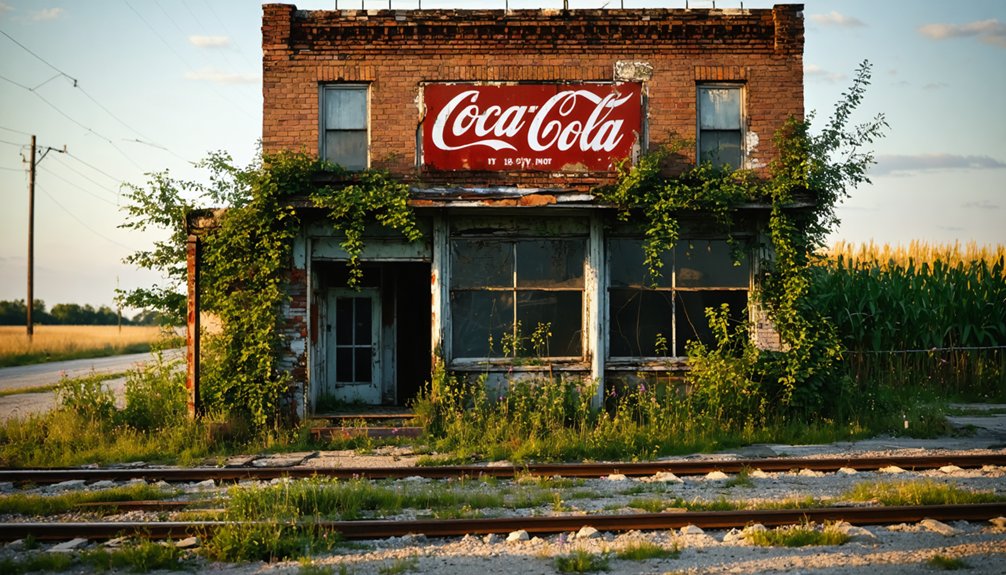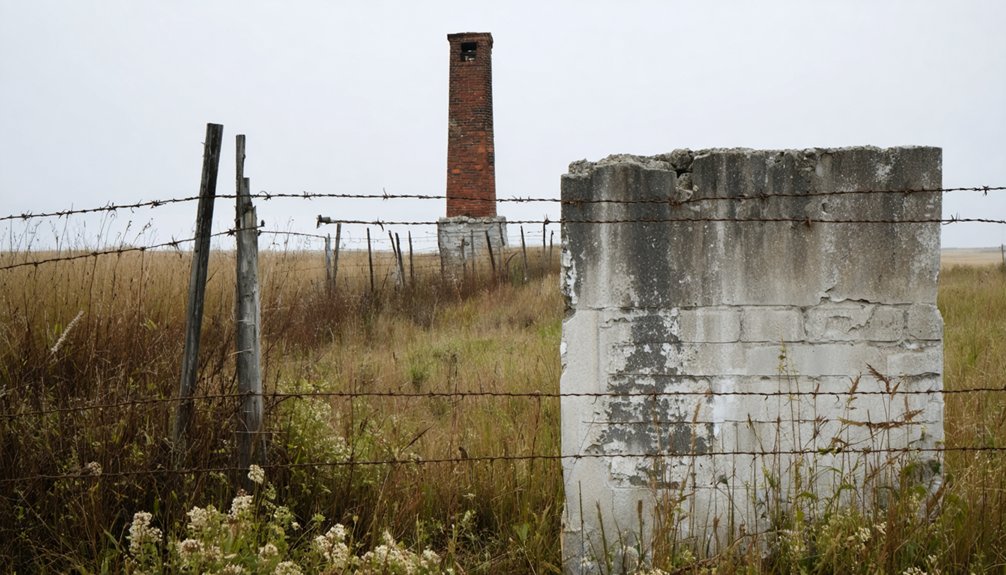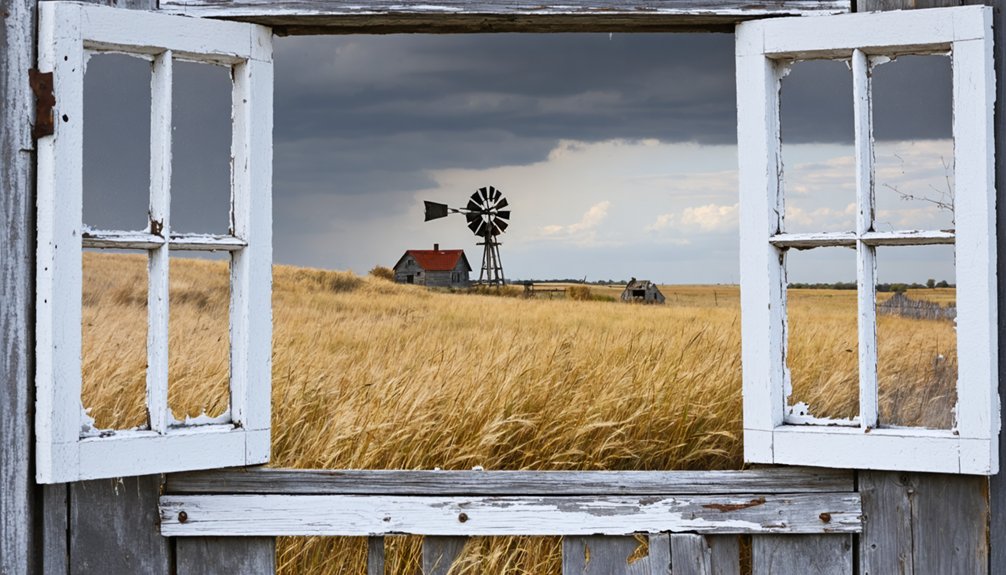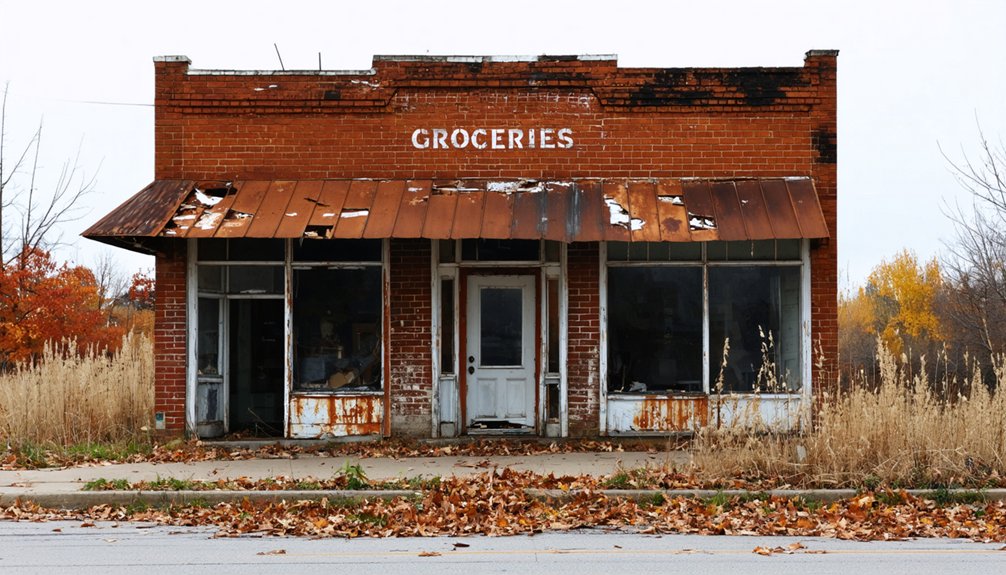You’ll find Conover’s dramatic rise and fall in northeast Iowa, where a bustling railroad boomtown emerged in 1864. Within months, the town exploded to 1,500 residents, featuring 32 saloons and W.W. Cargill’s first grain warehouse. A devastating 1869 fire, followed by the railroad’s shift to nearby Calmar, sealed Conover’s fate. Today, only scattered ruins and a weathered Gothic-windowed building stand where this frontier dream once flourished. The town’s swift transformation from boom to bust holds deeper lessons about America’s westward expansion.
Key Takeaways
- Founded in 1864, Conover rapidly grew to 1,500 residents within months due to the McGregor Western Railroad’s extension.
- At its peak, Conover boasted over 200 buildings, 32 saloons, and served as a major grain trading hub.
- A devastating fire in 1869, combined with the railroad’s relocation to Calmar, triggered Conover’s swift decline.
- The population plummeted from 168 residents in 1880 to just 49 by 1940, leading to ghost town status.
- Today, only scattered ruins, foundations, and a weathered Gothic-windowed building remain of the once-thriving railroad town.
The Birth of a Railroad Boomtown
When news arrived in September 1864 that the McGregor Western Railroad would extend through a local cow pasture, it sparked the rapid birth of Conover, Iowa.
A single railroad announcement in 1864 transformed an Iowa cow pasture into the burgeoning settlement of Conover.
Within just two weeks, surveyors had mapped out a village, and local settlers jumped at the opportunity to support the railroad expansion with their horses and wagons.
You’d hardly recognize the transformation that unfolded over the next year.
By August 1865, the rails had reached town via Calmar, and what was once simple grazing land had exploded into a bustling community of over 200 buildings.
It was during this pivotal time that W. W. Cargill established his first grain warehouse, marking the beginning of what would become a global agricultural empire.
The strategic location at the end of the McGregor & Western line turned Conover into a crucial grain trading hub, complete with 32 saloons and numerous produce markets – clear evidence of the community involvement that shaped this boomtown’s destiny. This location would later require careful link disambiguation to distinguish it from other places named Conover.
Peak Years and Economic Growth
During Conover’s peak years in the mid-1860s, you’d find a bustling railroad hub where the McGregor Western Railroad brought unprecedented growth and prosperity to the town.
Along Main Street, you’d encounter three hotels, dozens of stores, and over 32 saloons serving the town’s 1,500 residents and countless travelers. A devastating fire in 1869 marked the beginning of the town’s decline. By 1870, the once-thriving community had reverted to cropland.
The business district’s rapid expansion included the establishment of Cargill’s first grain flat house in 1865, alongside a dedicated street of warehouses that showcased Conover’s strategic importance in regional commerce.
Railroad Hub Development
Three pivotal developments transformed Conover into a bustling railroad hub in 1864-1865: the McGregor Western Railroad’s westward expansion, William Wallace Cargill’s strategic grain operation, and the rapid construction of over 200 buildings.
You’d have witnessed an explosion of railroad infrastructure as the rails reached town in August 1865, positioning Conover as a crucial terminus. The economic implications were immediate – 32 saloons sprang up alongside produce markets and grain storage facilities. Passenger fares remained competitive at 2-3 cents per mile, making rail travel accessible to most residents.
You could’ve watched Cargill’s grain flat house become the cornerstone of what would grow into an agricultural empire.
As Iowa’s rail network expanded from 655 to 2,683 miles in that decade, you’d have seen Conover’s strategic position strengthen through essential connections to Minneapolis-St. Paul and Chicago markets.
Thriving Business District
After the railroad’s arrival in 1864, Conover’s business district exploded into a vibrant commercial powerhouse, packing over 200 buildings into its newly plotted streets.
You’d find yourself amid unprecedented business prosperity as 32 saloons, multiple general stores, and bustling warehouses lined the streets, serving a peak population of 1,500 residents.
At the heart of this economic surge, you’d witness William Wallace Cargill establishing his grain empire in 1865, while community dynamics thrived through the interplay of hotels, merchant shops, and grain trading facilities.
Eastern investors poured money into local real estate, driving up property values and creating numerous job opportunities.
The town’s strategic position as an agricultural hub attracted traders and entrepreneurs, making Conover a symbol of frontier commercial success.
The Devastating Fire of 1869
A devastating fire tore through Conover in 1869, marking a turning point in the town’s short-lived prosperity. As flames engulfed numerous buildings, you’d have witnessed the destruction of crucial businesses and infrastructure that had made the town a bustling railroad stop just years before.
The fire’s aftermath proved catastrophic, as many residents chose to abandon their properties and seek opportunities elsewhere. Today’s metal detector enthusiasts frequently explore the area’s ruins for historical artifacts.
The historical significance of this disaster can’t be understated – not only did it destroy physical structures, but it also claimed irreplaceable town records that would have documented Conover’s brief but vibrant history.
Today, you’ll find few traces of the original town, though a monument to Whiskey Row stands as a memorial to what was lost in that fateful blaze of 1869.
Calmar’s Rise and Conover’s Fall
You’ll find that Conover’s destiny changed dramatically when the railroad operations shifted to nearby Calmar, transforming the latter into Winneshiek County’s dominant rail center.
The migration of railroad facilities brought with it a mass exodus of Conover’s population and businesses, as workers and merchants followed the economic opportunities to Calmar.
The Milwaukee and St. Paul Railway initially bypassed Calmar in 1864, making Conover the temporary terminus before the eventual shift occurred.
Calmar’s importance as a regional hub continued to grow, and by 1966 it was chosen as the administrative headquarters for Area I Vocational-Technical School.
While Calmar flourished with a growing population reaching 1,100 by the 1900s and extensive railroad infrastructure including a roundhouse and passenger depot, Conover dwindled until it existed in name only.
Railroad Hub Transfer
During the late 1800s, Conover’s status as northeast Iowa’s primary railroad hub began shifting dramatically to the neighboring town of Calmar.
The town’s establishment as Calmar in 1854 set the stage for its eventual railroad dominance.
You can trace this historical change through the arrival of the Iowa and Dakota, and Iowa and Minnesota rail divisions in Calmar by 1869, marking the beginning of Conover’s decline in railroad significance.
The region’s railroad development continued to evolve as the Chicago Great Western Railway expanded its operations throughout Iowa into the early 1900s.
Population Migration Impact
While Calmar’s population steadily climbed from 617 residents in 1880 to over 1,000 by the early 20th century, neighboring Conover experienced a dramatic exodus that would ultimately lead to its ghost town status.
You’ll find that Calmar’s success wasn’t just about numbers – it reflects strategic migration patterns that favored towns with diverse economic opportunities.
With a median household income of $80,781 and a robust 73.5% homeownership rate, Calmar attracted families seeking stability.
The town’s connection to Northeast Iowa Community College and its position along U.S. Route 52 created a sustainable community structure that Conover couldn’t match.
These demographic changes transformed Calmar into a resilient hub while Conover’s population dwindled, highlighting how infrastructure and economic diversification can determine a town’s fate.
Business Relocation Effects
As the Milwaukee and St. Paul Railway shifted its operations from Conover to Calmar in 1869, you’d witness a dramatic business impact that transformed both communities. The economic decline of Conover was swift and devastating, with numerous enterprises following the railroad’s relocation.
Here’s what made this shift so significant:
- Cargill’s grain warehouse, established in Conover in 1865, eventually moved operations to maintain rail access.
- Warehouses, hotels, and stockyards abandoned Conover for Calmar’s growing transportation hub.
- Over 200 buildings, including multiple saloons, disappeared as Conover’s commercial base crumbled.
Life Along the Railroad Lines
The arrival of the railroad in Conover in 1869 transformed this small Iowa settlement into a bustling hub of commerce and activity, with Robert Jameson managing the first trains through the region.
Railroad culture quickly took root as workers, businesses, and residents clustered their buildings around the tracks, creating tight community connections centered on rail operations.
You’d have found a vibrant scene of railroad workers inspecting cars, station agents like Anna Becvar managing daily operations, and locals gathering near the tracks to witness the pulse of commerce flowing through their town.
But when the main station moved to Calmar that same year, Conover’s spirit began to fade.
While train inspections continued until the late 1940s, the gradual loss of railroad jobs and services eventually turned this once-thriving community into a ghost town.
Population Shifts Through the Decades

From its inception in September 1864, Conover experienced a dramatic population surge that transformed empty prairie into a bustling boomtown of 1,500 residents within months.
The town’s population dynamics were closely tied to the railroad’s presence, creating unprecedented demographic trends.
- By 1865, you’d find over 200 buildings, including 32 saloons and three hotels, serving the growing community of settlers and traders.
- The 1870s marked a sharp decline as the railroad shifted operations to Calmar, causing businesses to close and residents to scatter.
- Census records tell the tale of Conover’s fade into obscurity: from 168 residents in 1880 to just 49 by 1940, until the town ultimately became the ghost town you’ll find today.
The Last Train Departs
On August 10, 1954, locals gathered to witness Conover’s last regular passenger train roll through town, marking a poignant end to nearly 90 years of daily rail service that had transformed prairie into prosperity.
You’d hardly believe this was once a bustling railroad hub where William Wallace Cargill launched his grain empire. The last passenger service’s termination accelerated Conover’s economic decline, forcing businesses to relocate and residents to seek opportunities elsewhere.
What began with the McGregor Western line’s arrival in 1865 ended with Anna Becvar, the final railroad agent, closing up shop. The rail yards that once buzzed with activity had already wound down operations by the late 1940s.
Today, you’ll find only an abandoned depot and a single track – silent testimonies to a town that lived and died by the railroad.
What Remains Today

Scattered remnants of Conover’s past dot the landscape along its former railroad corridor, where aging structures from the late 19th century stand in various states of decay.
Today, you’ll find most of the town site converted to farmland, with only a handful of remaining structures hinting at its historical significance.
Fields stretch where a town once flourished, leaving only scattered buildings to whisper tales of its storied past.
As you explore the ghost town, you’ll discover:
- A distinctive wood building featuring Gothic windows, though weathered by time
- Foundation ruins marking where homes and businesses once thrived
- Original building clusters tracing the old railroad’s path
The former railroad facilities have vanished, and no formal historical markers commemorate the site.
While Conover’s physical presence has largely faded into the rolling Iowa countryside, its story lives on through local histories preserved in nearby Calmar’s archives.
From Bustling Hub to Farmland
Established in 1864 along the McGregor Western Railroad, Conover quickly transformed into a bustling frontier settlement that would reach its zenith just one year later.
By August 1865, you’d have found over 200 buildings, 32 saloons, and a population of 1,500 residents thriving in this Winneshiek County boomtown.
The economic shift began in 1869 when the railroad shifted its operations to nearby Calmar. After a devastating fire that same year, businesses and residents followed the railroad’s exodus.
This dramatic decline sparked an agricultural resurgence as former town lots were converted back to farmland. By 1880, only 168 people remained, and the population dwindled to just 49 by 1940.
The once-vibrant streets where merchants and settlers had gathered gave way to cropland, marking Conover’s transformation from frontier hub to fertile fields.
Frequently Asked Questions
What Happened to the Original Buildings That Weren’t Destroyed by Fire?
You’ll see most buildings crumbled away as residents fled to Calmar, leaving behind dilapidated structures. Despite minimal historic preservation efforts, only a few original houses remain, while others transformed into farmland.
Were There Any Notable Crimes or Lawlessness During Conover’s Peak Years?
You won’t find documented evidence of high crime rates or major lawlessness in historical records, despite 32 saloons suggesting potential disorder. No specific law enforcement incidents stand out during the 1865-1866 peak.
What Was the Average Property Value in Conover During Its Heyday?
Like a bustling saloon that sold for $1,200 in 1868, you’d find average property values during the economic growth period ranged from $300 for homes to $2,000 for prime commercial spots.
Did Any Famous People or Historical Figures Ever Visit Conover?
You won’t find records of any famous visitors to this railroad town. Despite its historical significance during the 1860s, no notable figures were documented spending time in this brief-lived community.
What Native American Tribes Originally Inhabited the Area Before Conover’s Establishment?
You’d find the Meskwaki (Fox) and Sauk tribes dominated the area’s Native American tribal history, while the Iowa, Winnebago, and Dakota peoples also maintained significant presence throughout the region.
References
- https://b100quadcities.com/six-ghost-towns-in-iowa/
- https://kids.kiddle.co/Conover
- https://en.wikipedia.org/wiki/List_of_ghost_towns_in_Iowa
- https://raregoldnuggets.com/?p=3950
- https://www.desmoinesregister.com/story/news/local/2022/10/24/170-iowa-ghost-stories-and-haunted-places-to-explore/69552812007/
- https://en.wikipedia.org/wiki/Conover
- https://www.cbsnews.com/minnesota/news/the-warehouse-that-started-it-all/
- https://www.thegazette.com/news/time-machine-from-conover-to-minneapolis/
- https://www.cargill.com/story/climate-change-and-the-future-of-food-production
- https://www.startribune.com/minnesota-history-cargill-has-humble-roots-in-iowa-and-wisconsin/293290331



